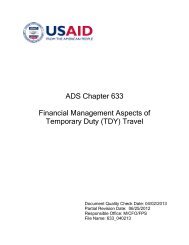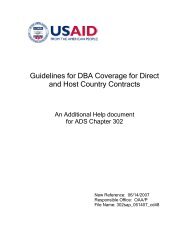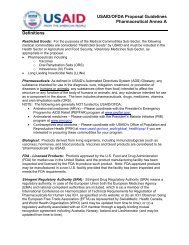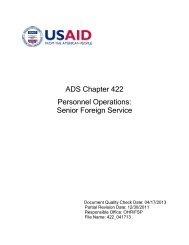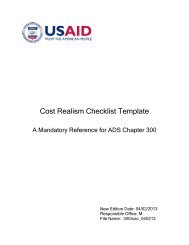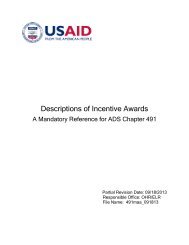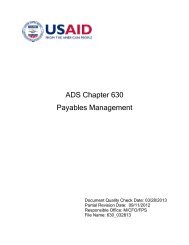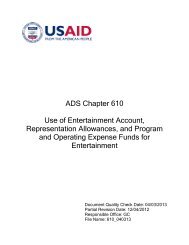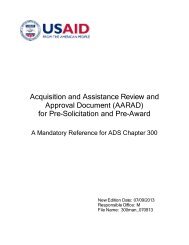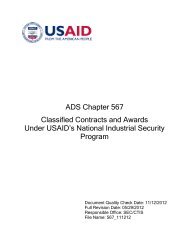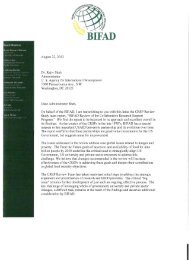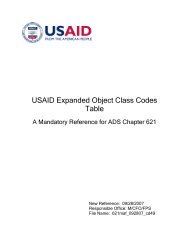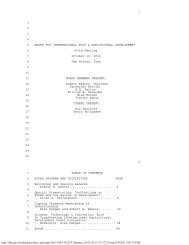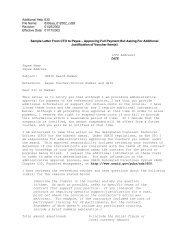USAID Policy Document - Resiliency FINAL 11-26-12.indd
USAID Policy Document - Resiliency FINAL 11-26-12.indd
USAID Policy Document - Resiliency FINAL 11-26-12.indd
- No tags were found...
Create successful ePaper yourself
Turn your PDF publications into a flip-book with our unique Google optimized e-Paper software.
4. ROBUST LEARNING AGENDARobust monitoring, evaluation, and learning agendas must accompanyour resilience efforts. We have placed a particularemphasis on monitoring, evaluation, and learning in the JPCs(and will do the same in other future areas of focus) in order touncover lessons learned in these regions and to allow us to capturethe successes and challenges of employing new approaches.Given the many forces impacting chronically vulnerable communities,monitoring and evaluating resilience-building efforts isa highly complex undertaking. Efforts to measure our ability to“build resilience” must be highly context specifi c. These effortswill require the use of both quantitative and qualitative data andindicators at multiple levels, including the resilience of people,households, communities, countries, and systems. Practice isevolving in this area. The international development communityis working to develop shared principles for measuring resilienceas well as specifi c indicators, with an emphasis on increasedadaptive capacity as a proxy for resilience itself, in the event thatno shocks hit during the period of collection. <strong>USAID</strong> is committedto extending and elevating these discussions. We are alsocommitted to involving affected communities in assessing thesuccess of interventions in ways that are meaningful to them.While there will be some common indicators across focusareas, many indicators will be contextualized and highly dependenton the nature of the local problems and vulnerabilitieswe are trying to address. Indicators such as the diversity oflivelihood strategies, assets, and social networks; propensity forhousehold savings; and fi nancial opportunities may, as part ofa set, provide insight into increased adaptive capacity. Gendersensitiveindicators are also important to our learning agenda. Inthe Horn of Africa, for example, our JPC is using the Women’sEmpowerment in Agriculture Index 20 to measure change in therole in household decision making around dry lands production,access to productive capital, income, leadership roles withinthe community, and labor time allocations. In addition, moretraditional development indicators – such as those related toincome, food security, and nutrition – will be critical, as willversions of these indicators that refl ect the distinct nature ofresilience investments. In the Horn of Africa and the Sahel,depth of poverty and global acute malnutrition will serve ascontextual complements to measures of prevalence of poverty,chronic malnutrition, and hunger, as measured by the HouseholdHunger Scale. 21In areas of recurrent crises, communities usually experience agradual worsening of conditions. Monitoring is an importantmechanism to diagnose conditions as they occur and allow us toreact accordingly. The interventions required to respond to highlydynamic environments will likely change as the situation evolves,as will the intended outcomes and, therefore, what teams areevaluating. A dynamic system for monitoring and evaluationshould enhance our capacity to adapt resilience programs to realconditions to build on what works while eliminating what doesnot. Importantly, these approaches must be undertaken collaborativelyby humanitarian and development teams to ensure thatunanticipated negative consequences are avoided.Finally, we will also use this policy and program guidance as aframework for evaluating the extent to which coordinationbetween humanitarian and development teams was achieved;lessons learned for future efforts; and which models of layering,integrating, and sequencing humanitarian and developmentefforts yield the greatest resilience gains. Evidence-basedknowledge regarding the effectiveness of alternative approachesto building resilience and cost benefi t analysis of these variousalternatives are especially high priorities for informing futureresilience programming.20 Learn more about the Women’s Empowerment in Agriculture Index at http://www.ifpri.org/publication/womens-empowerment-agriculture-index.21 For more information on the Household Hunger Scale, visit http://www.fantaproject.org/publications/tn12.shtml.23



